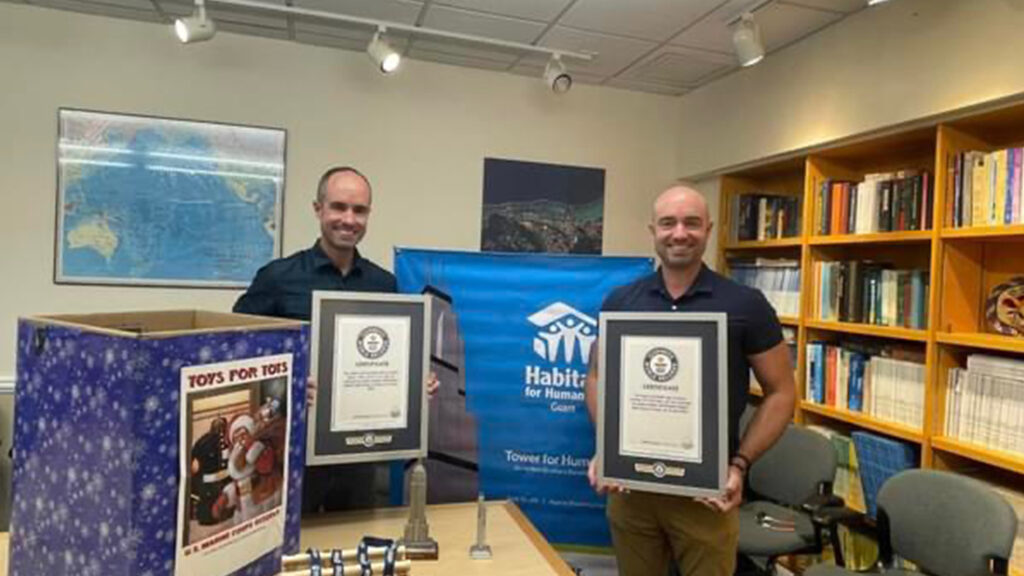The Typhoon Twins
NC State grads Brandon and Landon Aydlett used social media to alert residents of the dangers of a storm in Guam.

With winds reaching 140 mph, Typhoon Mawar ravaged Guam in late May to a level not seen in more than two decades. Trees were uprooted, buildings were damaged, and downed power lines meant most of the island was without electricity for at least a couple of days.
But it could have been worse if not for the efforts of Brandon and Landon Aydlett, twin brothers who work in the Guam office of the National Weather Service. The Aydlett brothers, both 2005 graduates of NC State’s meteorology department, used Facebook Live to keep people up-to-date on the storm as it approached and then swept across the island in the Pacific Ocean.
They worked around-the-clock to give residents the latest information and urge them to take the category 4 typhoon seriously.
And so, despite all the damage, no deaths have been attributed to Mawar.
“We were the only source of information,” says Landon Aydlett, noting that there are no weather broadcasters working for either of the two television stations in Guam. “If we’re not communicating on social media, we’re not getting the message out.”
Guam’s governor, Lou Leon Guerrero, joined one of the Facebook Live sessions from the National Weather Service office. “It really drove the message that this is going to be a significant and serious weather event,” Landon says. “We got so much feedback, not just from across the island, but also from folks nationally and internationally. It really struck a chord with a lot of people.”
So how did twin brothers who grew up in Elizabeth City, N.C., end up working in Guam? It started, ironically enough, with a storm. When the so-called “Storm of the Century” hit the eastern coast of the United States in 1993, Landon was intrigued by the impact that extreme weather could have.
“Prior to that I was more or less terrified of bad weather, but that superstorm sparked a lot of curiosity,” he says. “I was fascinated by the damage, the power of it, the flooding, trees down, and the conditions.”
Brandon, meanwhile, was considering majoring in music in college. But the more he thought about it, the less practical it seemed, and he decided to switch his studies to something that took advantage of his aptitude for science and math. He joined his brother at NC State to study meteorology.
“But I did not want to say anything at first, because I knew people were going to say, ‘Oh, your brother’s doing it so you’re just trying to follow him,’” he says. “‘You just want to stay close to your brother,’ and I didn’t want to deal with that.”
He did deal with it, though, even if it meant that professors occasionally got confused about which grade to give to which brother. “I thought it was to my detriment,” Brandon says with a laugh.
The brothers had difficulty finding a meteorology job after they graduated, waiting tables and taking other service jobs until they decided to return to NC State to get a master’s degree. But then Brandon got a break, when he was offered a contract meteorologist job in the Marshall Islands. “I had never heard of the Marshall Islands,” he says. “But when I saw the position, it was like, ‘Whoa, this looks really interesting.'”
So Brandon quickly packed up and moved, leaving Landon behind in graduate school. But when another job on the islands opened up, Landon followed his brother to their new home in the Pacific Ocean. In 2010, Brandon moved on to the NWS office in Guam, with his brother following a few months later. Brandon now works as the science and operations officer, and Landon is a warning coordination meteorologist.
While they never intended to be co-workers, they both enjoy their jobs and their life in Guam. “The people are nice and it’s exciting because it’s such an easy hop to so many places,” Landon says. “It feels kind of surreal. It’s not just a typical job like it is in the United States.”
Their efforts during the storm raised their profile in their community, but they had already drawn attention last year when they succeeded in setting a couple of Guinness world records by building the tallest structure ever with toy lumber logs. Their replica of Chicago’s Willis Tower was built to help raise funds for Habitat for Humanity of Guam (Brandon, left, and Landon hold their Guinness certificates, below).

Both brothers shy away from describing their experience with Typhoon Mawar as a career highlight, mindful of the devastation the storm caused on Guam. Brandon says, though, that it was a “benchmark” storm that heightened their appreciation for the need for timely communication.
“You can issue a watch or you can issue a warning, but if you don’t explain what that is, people don’t know what it means,” says Landon. “That communication is what people need. That’s what they want.”


